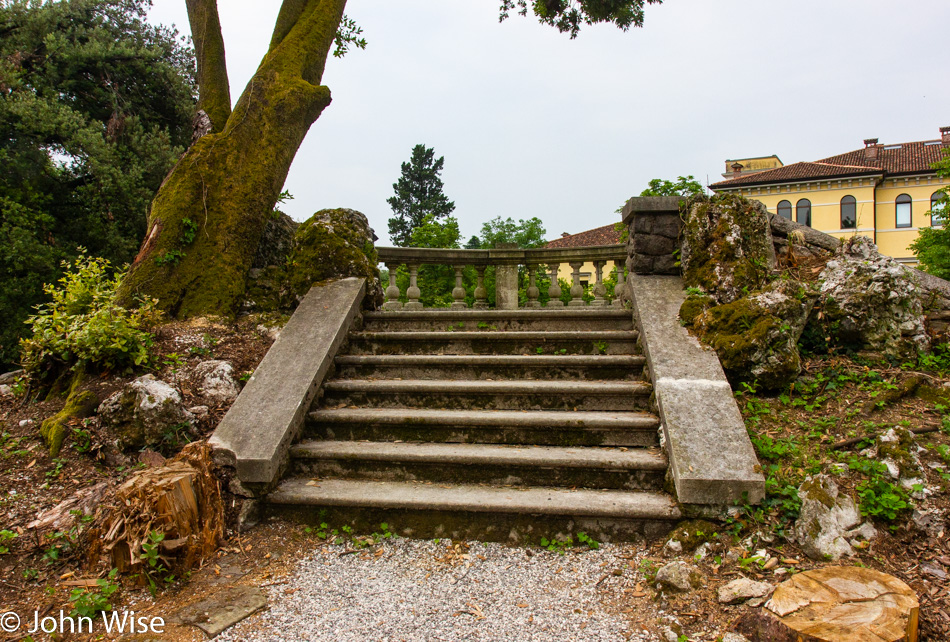
Gorizia was a stopover city on the way to Budapest, and as such, we had nothing on the agenda aside from sleep and depart. We weren’t feeling pressed for time, though, so we decided to take a walk around town and see if we can’t find a little charm here. Around the corner from our apartment, we stopped at the first cafe we came across for a cappuccino and a couple of sandwiches to fuel our expedition. Gorizia is definitely not on the tourist map, though it is at an interesting crossroads between Trieste, the Italian Alps, Slovenia, and Venice. Our path took us through a nearby park and while it even had a palazzo this morning’s lighting and skies didn’t make for a very photogenic environment.

If there is a history to the statue or the barrier wall, it wasn’t going to be known by us. Nothing much is open yet, and the only other people here with us are the groundskeepers.

I have a thing for signs, abandoned buildings, ruins, and store facades. I suppose the larger truth is that I have a thing for geometry and symbolism, especially when found in my environment. If I lived here in Gorizia (the thought has crossed our minds), this would be a shop that I would find appealing for its inherent funkiness. I don’t even care what they sell; I would be a customer because a place like this lends character to its visitors.

The remnants of posters dating to Italy’s tumultuous flirting with communist revolutions must certainly be buried on this wall. Political and art actions have been hallmarks of Italy’s history, and while these particular posters don’t really convey much to me, what they do tell me in my interpretation is more important to my imagination than what they might truly represent.

Is it just me, or is there something a bit Arabic or Near Eastern about this building? Here at the edge of Eastern Europe, there is probably a rich history of melding cultures, but our artificial intelligence-driven augmented reality travel apps are yet to arrive.
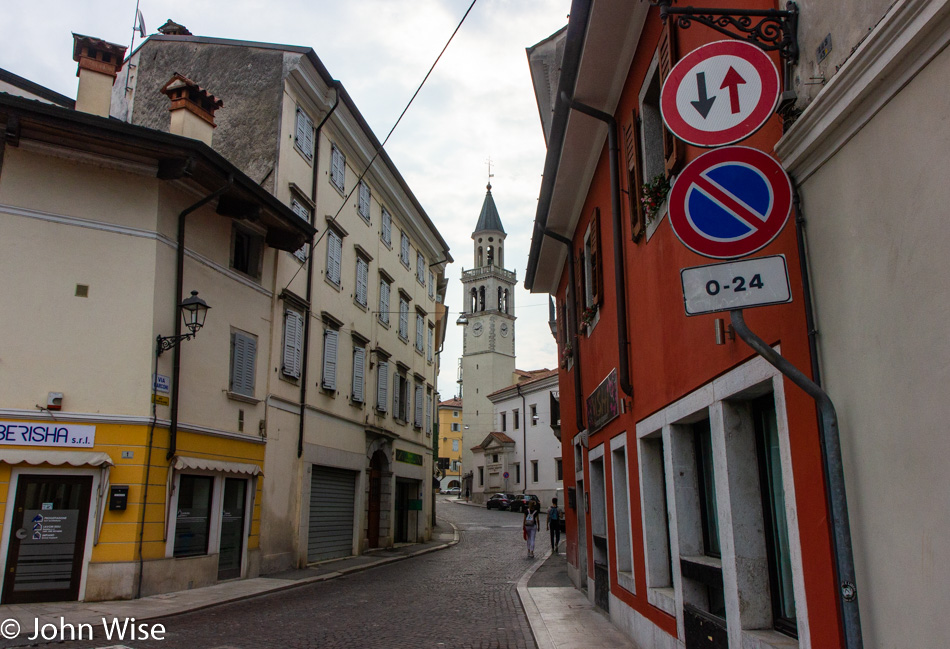
A church comes into view, and now we have a destination and the promise of a hidden treasure.

It’s neither spectacular nor too plain, so I’ll rank this one as somewhat below average but a bit better than a simple chapel.

Still, here is an elegance of effort and ambiance that to the inhabitants of Gorizia this church must be a milestone in the history of the town and as a monument to God. What is it about the lines, arches, lighting, and artwork that draws us in? Is it just nostalgia for something I was more familiar with as a child? Or is there a kind of magic to the order of geometry and light that resonates with us humans who are looking for patterns?

While Caroline doesn’t know her way around town, this bronze statue of that dude that is a metal hero to the people of Gorizia, she certainly knows more than his empty head, and so she’s pointing out where the nearest gelato shop is because she’s friendly that way. Okay, enough tongue-in-cheek nonsense; this is Carlo Michelstaedter, who died young, at the age of 23, more than one hundred years ago. Carlo was a philosopher and writer who took his own life.

I don’t know if it’s the arches or the orange building that is talking to me in this photo; it’s probably the orange. You might then ask, if I like orange so much, what is my problem with Donald Trump? The orange facade adds beauty, the fruit of the orange carries nutrition, the orange of the apricot is sweet and succulent, while my president is the antithesis of beauty, health, and things that are sweet.
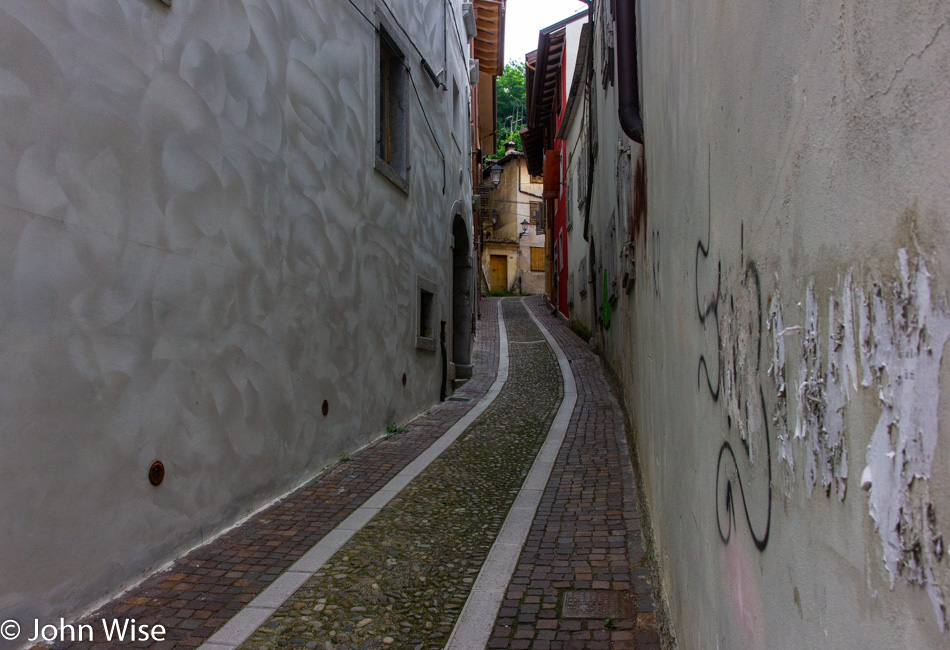
Peeling posters, graffiti, a curving narrow street, and the mystery of what lies beyond the corner all make for an appealing turn and walk down a path of which we do not know where it leads.
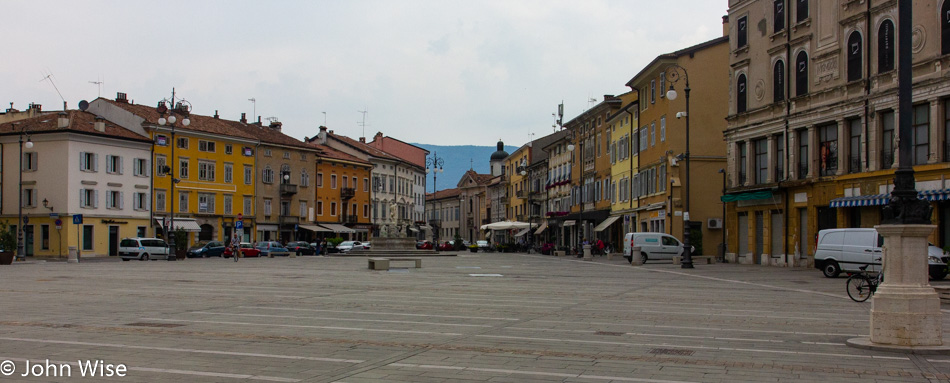
The town square of Piazza Della Vittoria in Gorizia: Tuesday is apparently the wrong day to find a bustling market set up for the gastronomically enhanced photos of the traveler. Just as the piazza is empty today, the lack of sunshine also puts some damper on the appearance of things. I wonder if we had been here on Friday night, if we would have found a busy square full of reverie and vendors hawking their wares the next day?

Also on the piazza, to the left in the previous image, is the Church of Saint Ignazio, which dates back to 1654. Maybe I should start keeping score of how many churches, doms, basilicas, and chapels we have visited on this trip.
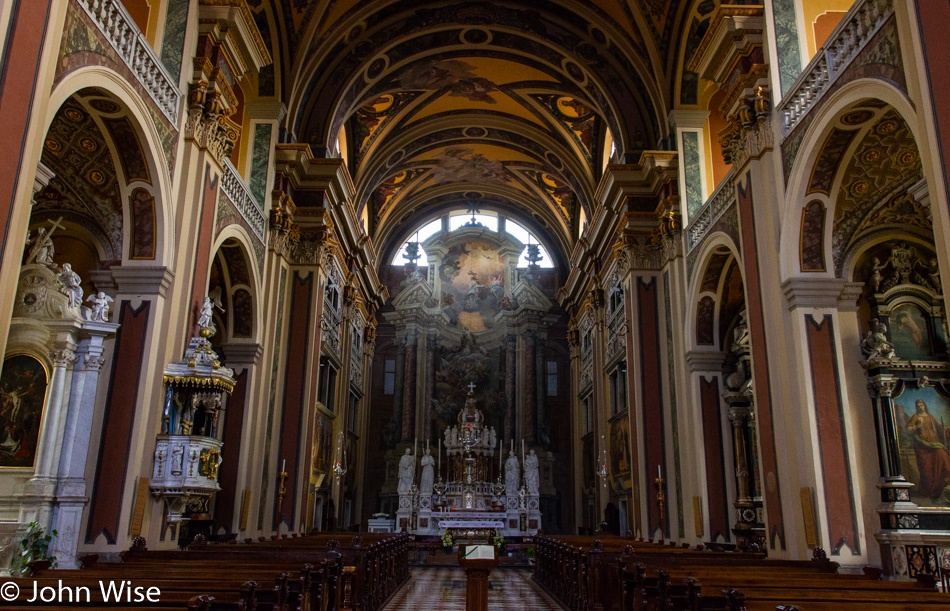
Reconstruction work on the church ended in 1767, and in 1769, the church was first consecrated by Archbishop of Gorizia Carlo Michele d’Attems. Twenty-three years later, the church was gutted as war broke out between Austria and France. Today, while its original treasures may have been stolen, the place looks amazing to me.
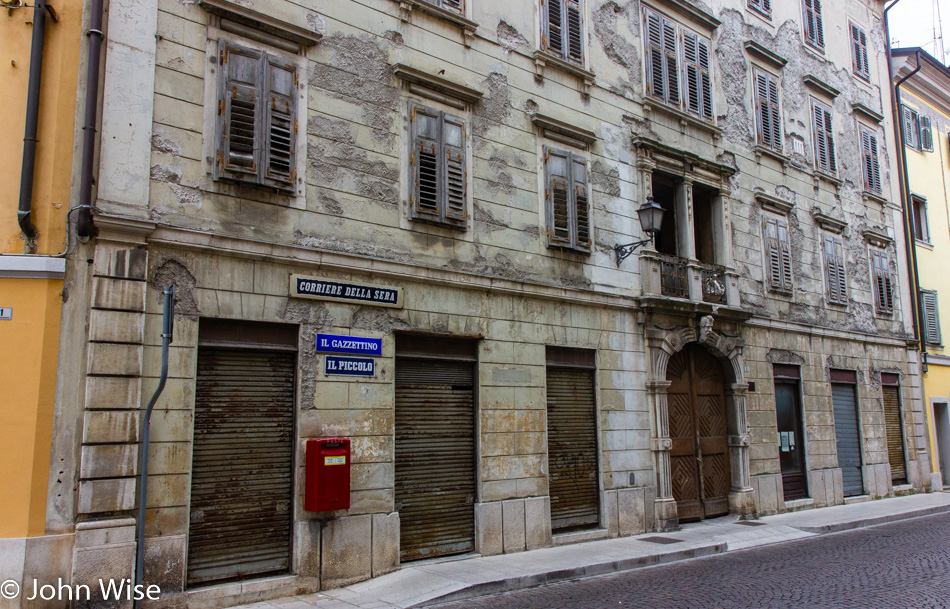
I can only imagine how difficult and expensive it is to maintain buildings that are centuries old. If all of the apartments are owned by individuals, then they collectively have to come up with the monies to restore their homes, and if they are on fixed incomes that can be costly. If the building is owned by an individual who is renting the units, he must deal with the cost alone, as raising the rent on people who may not have the greatest job prospects can create a situation where the owner won’t have tenants. The good news is that the apartment building we were staying in was either new or freshly renovated, so some investment Euros are going into Gorizia.
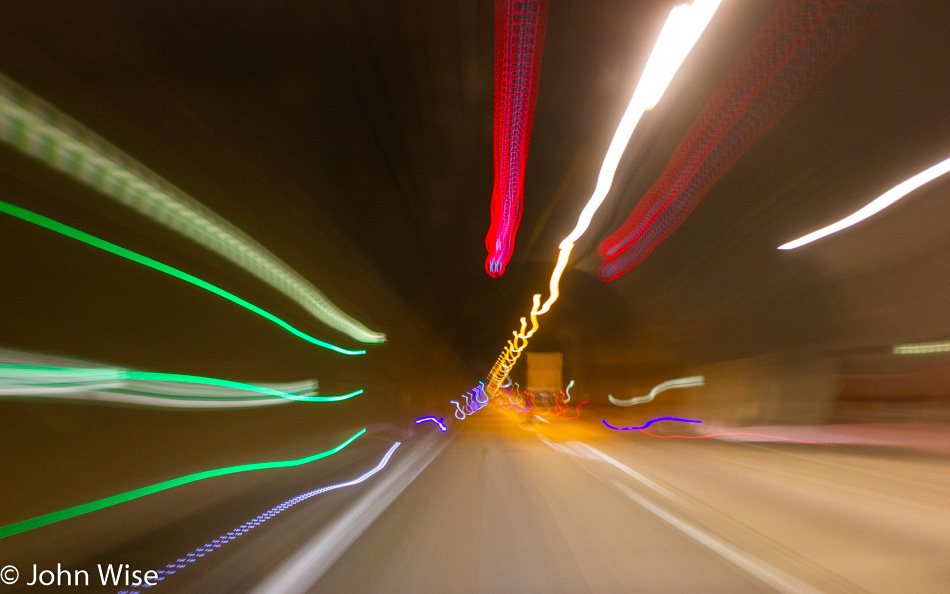
The speed in this tunnel was a relatively slow 80km per hour (about 50mph), so it was totally safe to drive and take long exposure images until I got one I really liked. We drove into Slovenia in the direction of Ljubljana (Laibach for the German speakers). We are on our way to Budapest, Hungary.
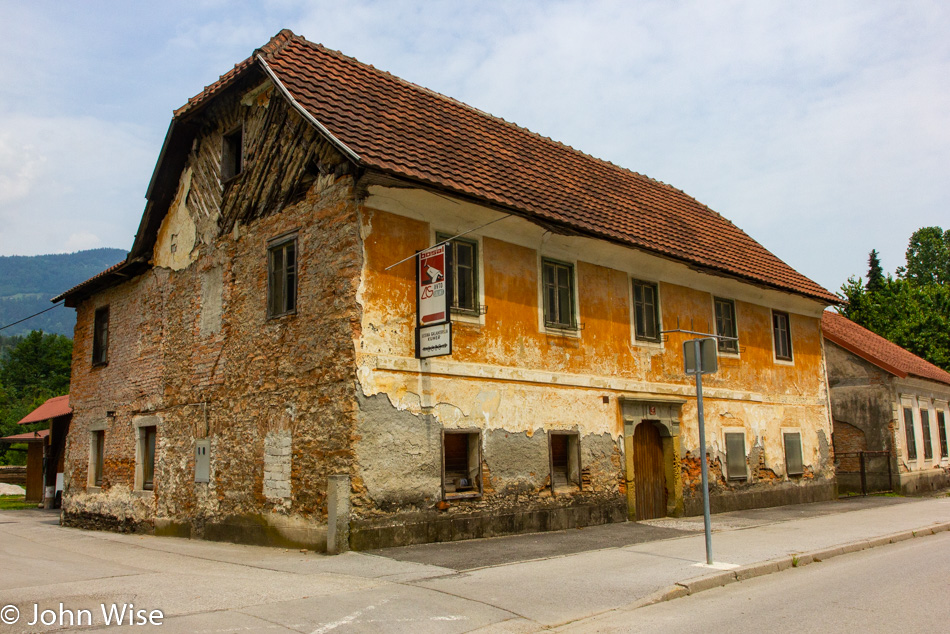
We’d been driving long enough that the weather was starting to clear with the promise of blue skies on our horizon. The problem I was having wasn’t the turning weather but my closing eyes. At the next available offramp that looked like we might find coffee and some lunch, we left the highway. We have entered the town of Vransko, Slovenia, and wondered if we might be the first foreign visitors ever.
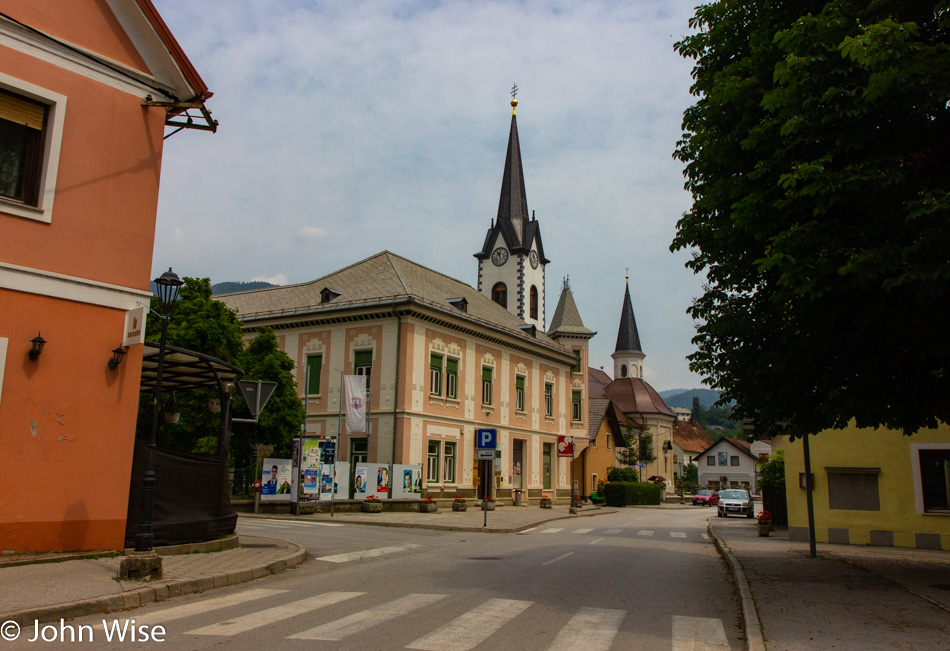
Well, that stupid assumption proved hugely false as this town hosts the Grom Motorcycle Museum, which likely attracts people from many countries. Oh, and that’s a church over there.
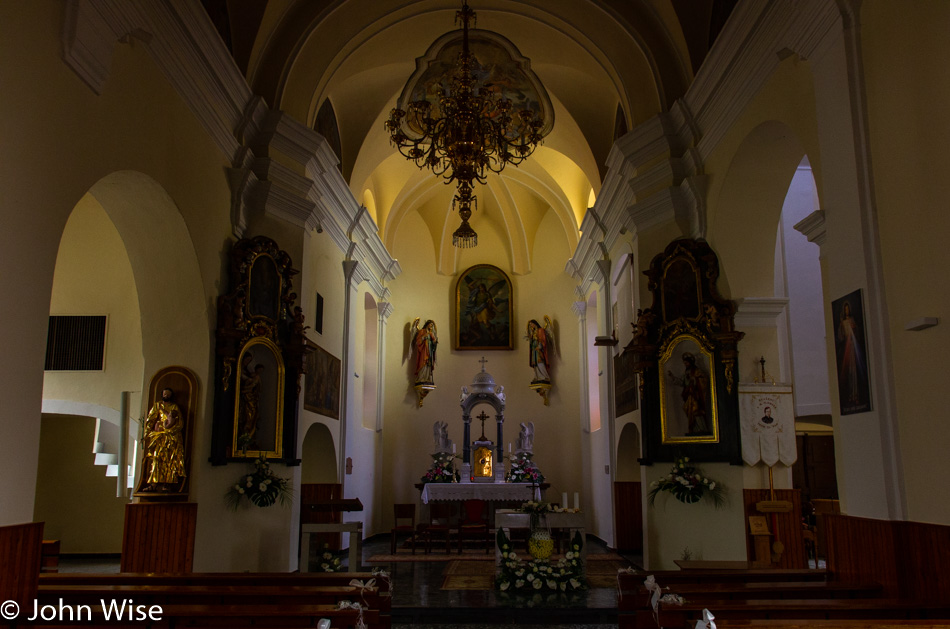
At this rate, I will have been to more churches on a single vacation than I have been collectively throughout my entire life. Maybe I need a numeric ranking system to place these churches on a scale of relatively positive impressions.
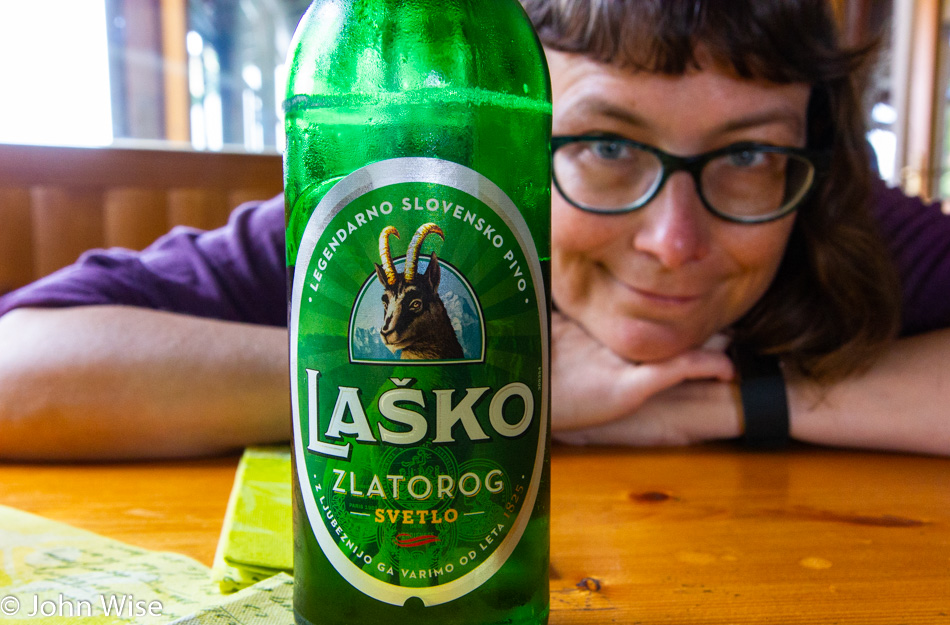
We found a place for coffee across the street from Gostilna Slovan for lunch, and while I’m drowsy, I’ll opt to have the coffee after something to eat. In Italy and France, we ran into enough people that spoke German or English, this is our first encounter with staff that speaks Slovenian and no other language Caroline or I are versed in. No problem because the menu is in four languages, and pointing is the universal language of the traveler. By the way, it’s usually pretty easy to identify the local beer as the logo is often part of the signage somewhere in the restaurant or out front.
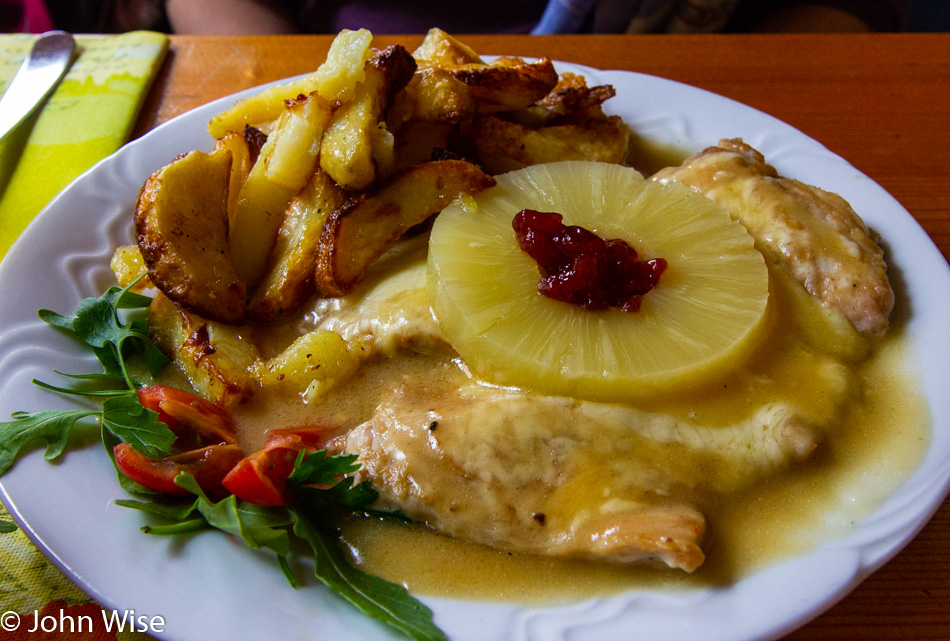
Caroline was the winner of ordering the best dish for this meal (a trend was in the making), a pork cutlet with pineapple and lingonberry with a side of bratkartoffeln (roasted potatoes).
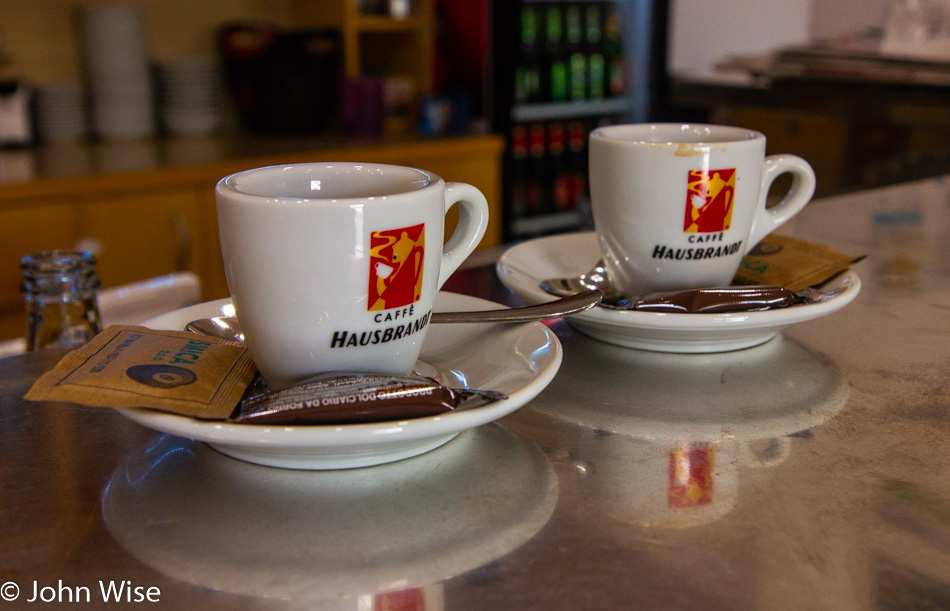
Back across the street, we ordered two espressos, and with Caroline having looked up the proper etiquette for drinking coffee in Italy (we became aware that we were noobs to drinking coffee correctly), we stood at the counter to quickly (in about two minutes) drink our espresso. We have now graduated from the basics and will have to move on to mastering when it’s appropriate to drink cappuccino.
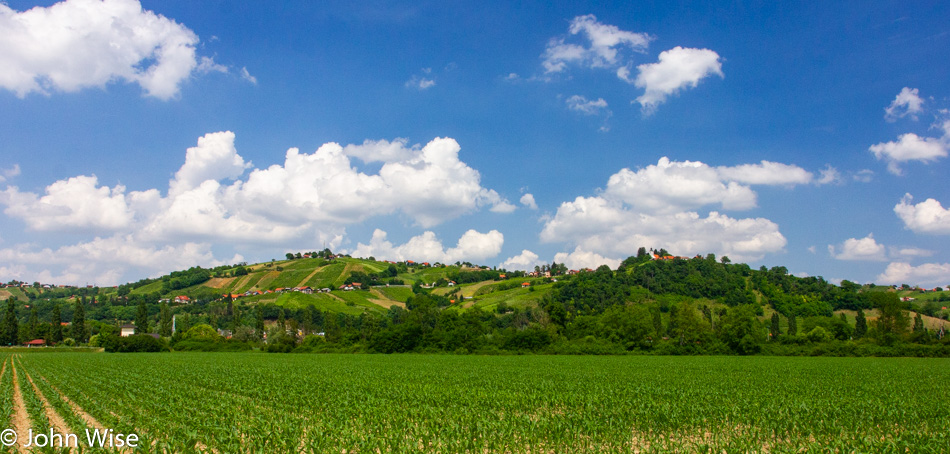
The road is short across Slovenia as we had decided earlier to try to take in a National Park area in Hungary. If you look closely, you might notice that the crop is corn and that the sky has turned to shades of spectacular. My choice of superlatives is limited by a poor vocabulary while I desperately try to find other succinct words to adequately describe views I find amazing, I come up short and must rely on well-worn words that are often less than spectacular.
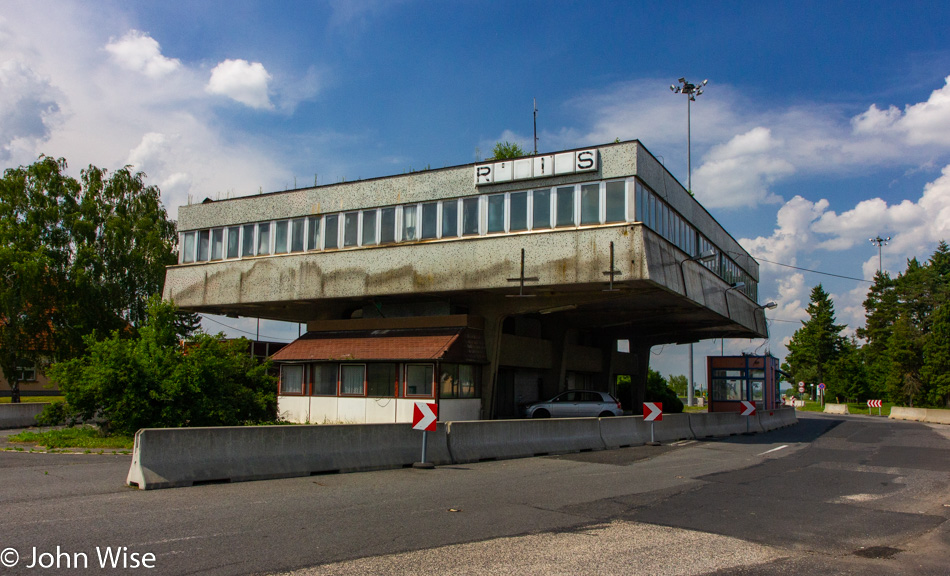
A relic from an older version of Europe: a border crossing station. Now defunct, one can’t help but wonder about the dark atmosphere of oppression during the Cold War when Westerners would cross this border that led into the empire of the Union of Soviet Socialist Republics.
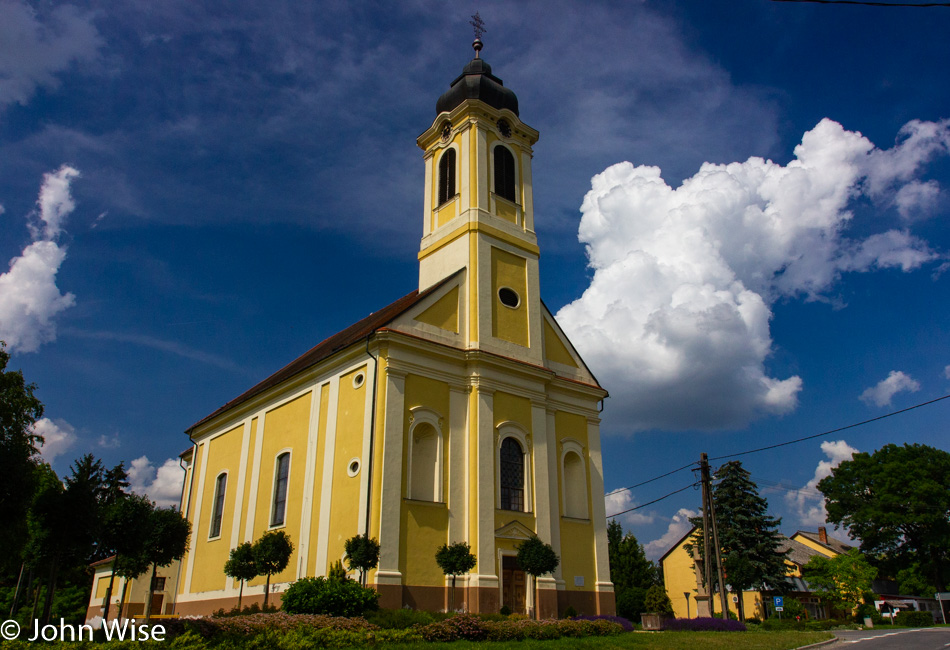
Breaking the rules as we didn’t even attempt to open the door of the next church we stopped at. This one was just for the photograph that demanded to be taken. Because we had a destination in mind before the main destination, we had to keep moving. While distance may not be great between places in Europe, country roads can be winding and languorous, with many slowdowns as we enter the endless string of small towns.

If we don’t stop to capture the path, we might forget what we saw along the way.

Look to the hilltop, and you will find a castle. If we were spending a week exploring Hungary you can safely wager that we’d be finding the road that would lead us up there. I should also point out that we are now in the National Park, though there hasn’t been a sign officially designating the area as such.
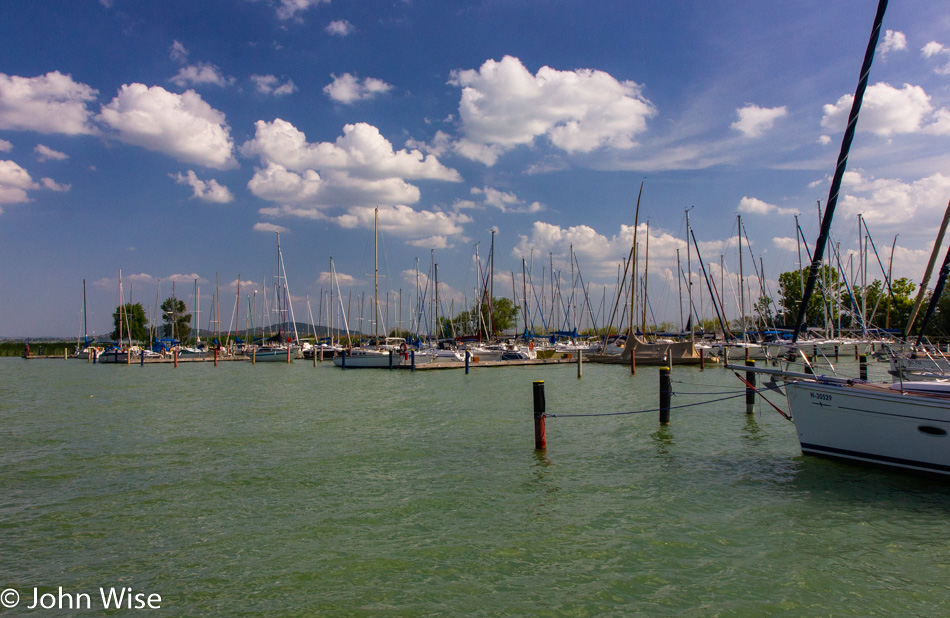
Lake Balaton. During the heyday of the “Worker,” this was a mecca for many a subsidized vacation to relax by the soothing waters of Lake Balaton. Today, the area is seeing declining visitor numbers as people in the region can opt to visit Mallorca, the Mediterranean, or even Cuba instead of being landlocked behind an Iron Curtain.
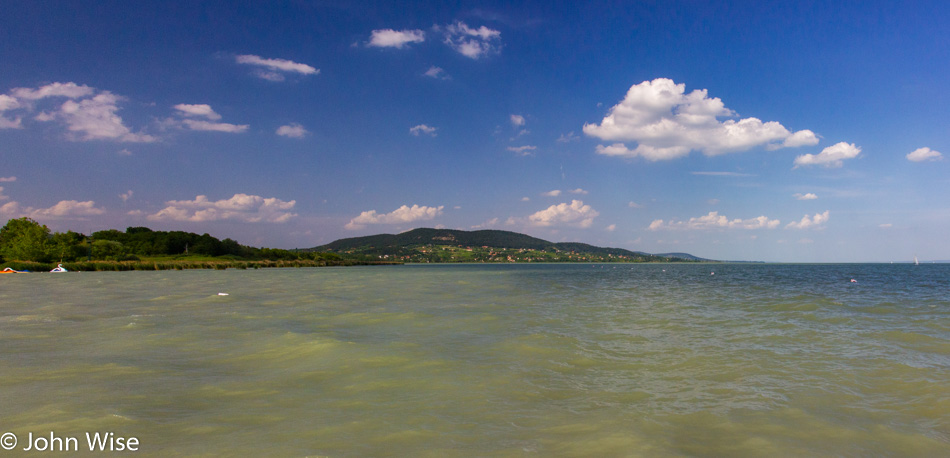
Getting this photo was a risky business; I had to leave Caroline in the running car in the parking lot, which required payment to be there. The problem was that to pay for parking, you couldn’t use Euros because Hungary hadn’t joined the common currency. As we hadn’t exchanged money yet, we were kind of stuck. So Caroline waited while I ran over to the edge of the lake to snap off a panorama and make a silent wish that maybe someday we’d come back and go for a swim or paddle out on the lake.
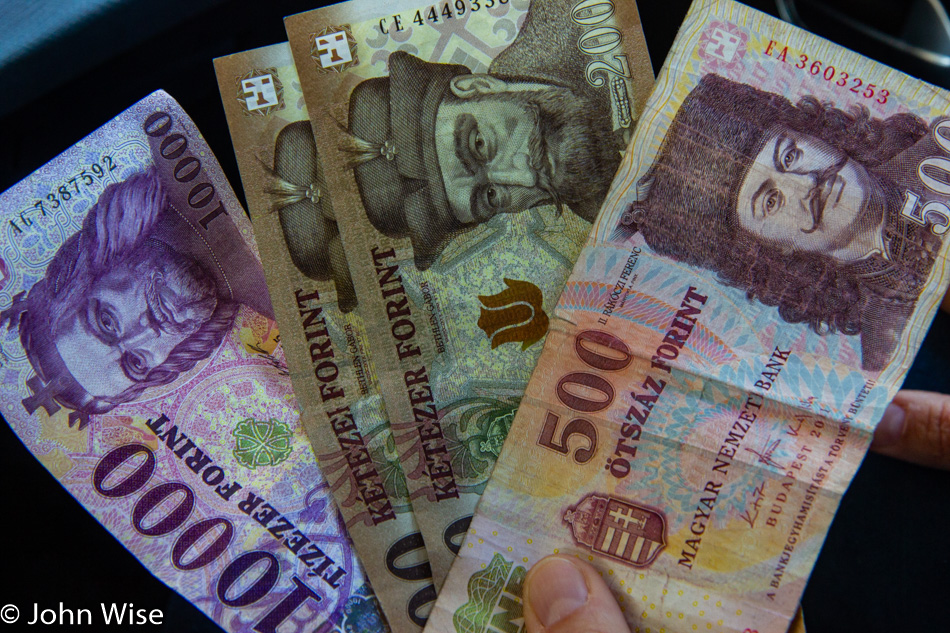
The trusty search engine let us know that we could exchange money at almost every gas station, and before we knew it, we were rich with thousands of colorful Forints.
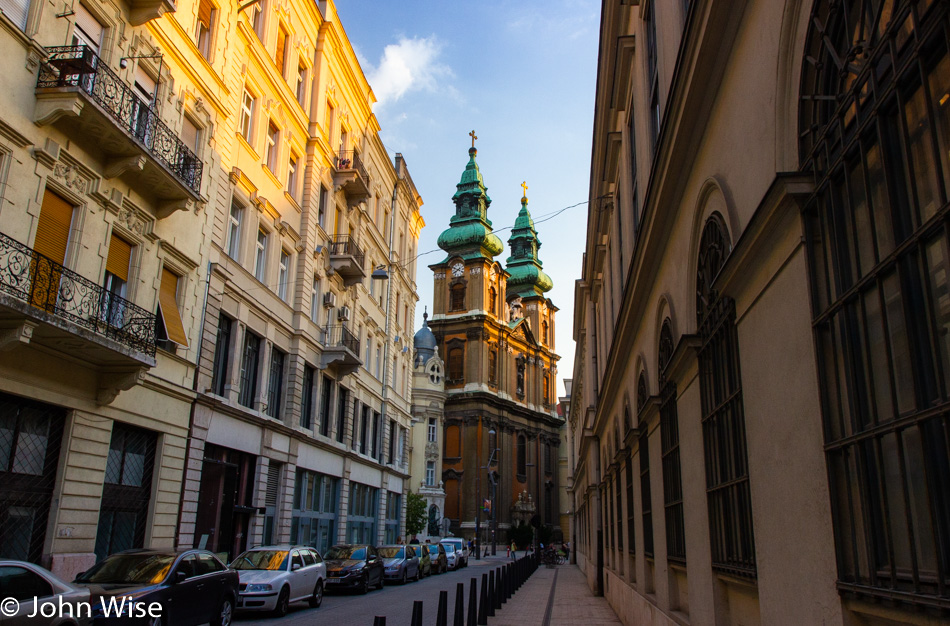
We move into Budapest with efficiency delivered by GPS that directs us on the most direct route to our apartment. Good thing, too, as traffic here is no better than what we found in Frankfurt, Verona, or Bergamo. The shadows are long, and the sun is low in the sky before we can get back out on the street in search of dinner.

Our dinner was kind of meh; we can’t always pick the winners, and tonight was one of those times. After dinner, though, we were greeted with a sunset that is found in dreams and made up for everything that may have been missing from the culinary introduction to Budapest. To offer more details, I should explain that we wanted the “true” taste of Hungary and opted for a restaurant probably no longer popular with the locals but “authentic” enough to bring business and family visitors for that “real” Hungarian experience complete with live music. Choose carefully, as we did not. The first clue when entering a Hungarian restaurant is: if the place and or the patio is empty, do not eat there.

We continued to explore the city and do some minor window shopping, though we were more intrigued with the hedonistic sense of Bohemian debauchery that seemingly many visitors come to Budapest for. If you want to smoke everywhere, walk around with a beer or bottle of wine, and grab a quick Thai massage, you will instantly know why Budapest is high on many people’s list of great cities to visit. On the other hand, if you are in love with history, this is also a city for you, and tomorrow morning, we will embark on that part of our exploration of this grand city on the Danube.
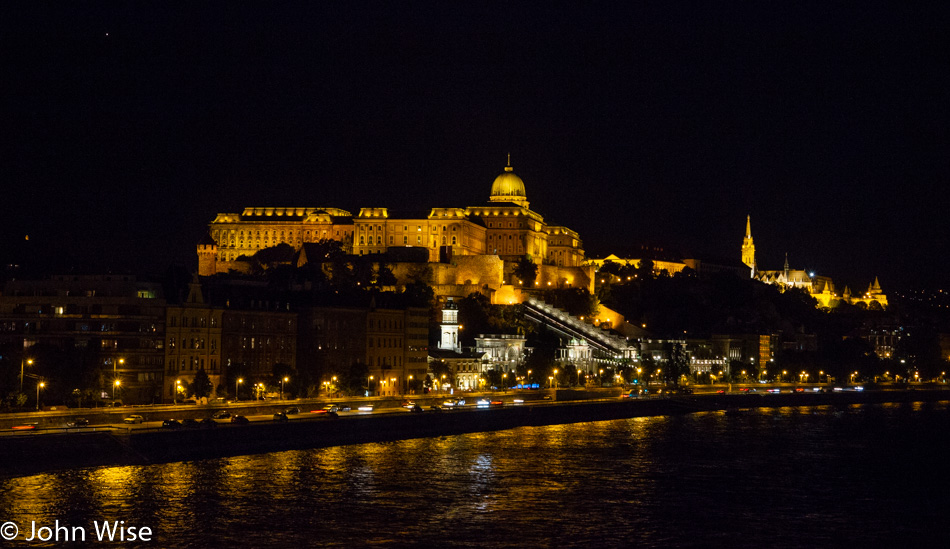
Before calling it quits for the day, we somehow ended up at nearly the same place we took the sunset photo of the Buda side of the Danube from the Pest side where our apartment is. For those of you who didn’t know, Budapest is the joining of two different cities that straddle the river, which is known here as the Duna. See you tomorrow on day 11 of our 23-day European vacation. Walking stats: 8.29 miles (14.4 km) and climbed 16 floors.